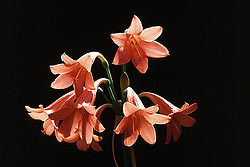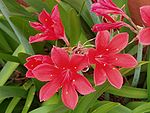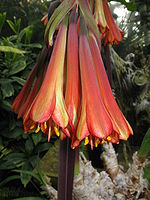- Cyrtanthus
-
Cyrtanthus 
Cyrtanthus Scientific classification 
Kingdom: Plantae clade: Angiosperms clade: Monocots Order: Asparagales Family: Amaryllidaceae Subfamily: Amaryllidoideae Genus: Cyrtanthus
Aiton[1]Species See text.
Synonyms - Anoiganthus Baker
- Vallota Salisb. ex Herb.
Cyrtanthus is a genus of perennial, herbaceous and bulbous plants in the Amaryllis family (Amaryllidaceae, subfamily Amaryllidoideae[2]). This highly ornamental genus encompasses about 60 species. It is endemic in the southern and eastern parts of Africa and is represented in all nine provinces of South Africa, with the highest concentration of species occurring in the southern parts of Eastern Cape. The name Cyrtanthus refers to the curved perianth tube of many of the species and is derived from the Greek kyrtos meaning curved and anthos meaning flower. This genus is highly valued horticulturally. Species differ greatly in the colour, size, shape and position of the flowers.[3]
Contents
Description
Species of Cyrtanthus are perennial bulbous herbs. The foliage varies among the species, from very narrow and spreading to strap-shaped and erect and it is produced with or after the flowers, depending on the species. The scape is hollow and the inflorescence has 1-4 flowers, subtended by two free bracts. The flowers vary from tubular and pendulous to widely bell-shaped, spreading or erect. The colours of the flowers range from white and cream to numerous shades of pink, red, orange and dark maroon. Androecium consists in 6 stamens that are inserted in the perianth tube. The fruit is a capsule which contains many black, flattened, and winged seeds.[4][5][6][7]
Distribution and growth habit
Members of Cyrtanthus can be separated into two groups according to their growth habit, namely deciduous and evergreen species. The deciduous members may be further divided into either winter- or summer-growing species: the winter-growing species occur mainly in the southwestern and southern Cape; and the summer-growers are found in the southern, eastern and northern parts of South Africa. The evergreen species occur mainly in the southern and eastern parts of the country, and include C. mackenii and C. brachyscyphus. A notable exception is C. herrei, an evergreen species that occurs in the arid Richtersveld in the far northwestern corner of Northern Cape.[3][5]
Taxonomy
Cyrtanthus is the single member of the tribe Cyrtantheae an African tribe which is separated from all other African tribes of the family due to the flat, winged phytomelanous seed characteristic of many American genera of Amaryllidaceae. Also, it is the most diverse in floral morphology of any genus in the family.
Species
The list of Cyrtanthus species, with their complete scientific name and authority, is given below.[8]
- Cyrtanthus angustifolius (L.f.) Aiton,[9] Cape Province.
- Cyrtanthus attenuatus R.A.Dyer,[10] Free State to Lesotho.
- Cyrtanthus bicolor R.A.Dyer,[11] Mpumalanga to Swaziland.
- Cyrtanthus brachyscyphus Baker,[12] Eastern Cape Province to KwaZulu-Natal.
- Cyrtanthus brachysiphon Hilliard & B.L.Burtt,[13] KwaZulu-Natal.
- Cyrtanthus breviflorus Harv.,[14] Kenya to Sudáfrica.
- Cyrtanthus carneus Lindl.,[15] Southern Western Cape Province.
- Cyrtanthus clavatus (L'Hér.) R.A.Dyer,[16] Southern Cape Province.
- Cyrtanthus collinus Ker Gawl.,[17] Cape Province.
- Cyrtanthus contractus N.E.Br.,[18] South Africa.
- Cyrtanthus debilis Snijman,[19] Southern Western Cape Province (Outeniqua Mountains).
- Cyrtanthus elatus (Jacq.) Traub,[20] Cape Province.
- Cyrtanthus epiphyticus J.M.Wood,[21] Eastern Cape Province to KwaZulu-Natal.
- Cyrtanthus erubescens Killick,[22] KwaZulu-Natal.
- Cyrtanthus eucallus R.A.Dyer,[23] Mpumalanga.
- Cyrtanthus falcatus R.A.Dyer,[24] KwaZulu-Natal.
- Cyrtanthus fergusoniae L.Bolus,[25] Southern Western Cape Province.
- Cyrtanthus flammosus Snijman & Van Jaarsv.,[26] Eastern Cape Province.
- Cyrtanthus flanaganii Baker[27] South Africa.
- Cyrtanthus flavus Barnes[disambiguation needed
 ],[25] Eastern Cape Province.
],[25] Eastern Cape Province. - Cyrtanthus galpinii Baker,[28] Western Mozambique to South Africa.
- Cyrtanthus guthrieae L.Bolus,[29] Southern Western Cape Province.
- Cyrtanthus helictus Lehm.,[30] Eastern Cape Province.
- Cyrtanthus herrei (F.M.Leight.) R.A.Dyer,[31] Namibia to Western Cape Province.
- Cyrtanthus huttonii Baker,[12] Mpumalanga to Eastern Cape Province.
- Cyrtanthus inaequalis O'Brien,[32] Southern Western Cape Province.
- Cyrtanthus junodii Beauverd,[33] Northern Cape Province.
- Cyrtanthus labiatus R.A.Dyer,[34] Eastern Cape Province.
- Cyrtanthus leptosiphon Snijman,[35] Southern Western Cape Province.
- Cyrtanthus leucanthus Schltr.,[36] Southern Western Cape Province.
- Cyrtanthus loddigesianus (Herb.) R.A.Dyer,[37] Eastern Cape Province
- Cyrtanthus mackenii Hook.f.,[38] Eastern Cape Province to KwaZulu-Natal.
- Cyrtanthus macmasteri Snijman,[39] Eastern Cape Province.
- Cyrtanthus macowanii Baker,[40] Mpumalanga to Eastern Cape Province.
- Cyrtanthus montanus R.A.Dyer,[41] Eastern Cape Province.
- Cyrtanthus nutans R.A.Dyer,[42] KwaZulu-Natal to Suazilandia.
- Cyrtanthus obliquus (L.f.) Aiton,[9] Western Cape Province to KwaZulu-Natal.
- Cyrtanthus obrienii Baker,[43] Eastern Cape Province to KwaZulu-Natal.
- Cyrtanthus ochroleucus (Herb.) Burch. ex Steud.,[44] Southern Western Cape Province.
- Cyrtanthus odorus Ker Gawl.,[45] Southern Western Cape Province.
- Cyrtanthus rhodesianus Rendle,[46] Southern tropical Africa (Chimanimani Mountains).
- Cyrtanthus rhododactylus Stapf,[47] Cape Province.
- Cyrtanthus rotundilobus N.E.Br.,[48] Eastern Cape Province.
- Cyrtanthus sanguineus (Lindl.) Walp.,[49] Sudan to Tanzania, Eastern Cape Province to KwaZulu-Natal.
- Cyrtanthus smithiae Watt ex Harv.,[50] Eastern Cape Province
- Cyrtanthus spiralis Burch. ex Ker Gawl.,[51] Eastern Cape Province
- Cyrtanthus staadensis Schönland,[52] Eastern Cape Province
- Cyrtanthus stenanthus Baker in W.H.Harvey & auct. suc. (eds.),[53] South Africa.
- Cyrtanthus striatus Herb.,[54] Cape Province.
- Cyrtanthus suaveolens Schönland,[55] Eastern Cape Province
- Cyrtanthus thorncroftii C.H.Wright,[56] Northern Cape Province.
- Cyrtanthus tuckii Baker,[57] South Africa.
- Cyrtanthus ventricosus Willd.,[58] Southern Cape Province.
- Cyrtanthus wellandii Snijman,[59] Southern Cape Province.
- Cyrtanthus welwitschii Hiern ex Baker,[60] Southern Tropical Africa.
Ecology
Many members of the genus are known for their extremely rapid flowering response to natural bush fires, hence the common name, "Fire Lily" for several species. Indeed, species like Cyrtanthus contractus, widespread in the eastern half of South Africa, as well as C. ventricosus from the south western Cape, and C. odorus from the southern Cape, only flower after fires.[3]
Conservation
Several Cyrtanthus species are widely distributed in nature, like C. contractus and C. sanguineus. However, there are a large number of extremely rare species, restricted to very narrow distribution ranges, such as C. guthrieae which is only known to occur in a limited area of the southern Cape, and C. erubescens, confined to just a few localities in the KwaZulu-Natal Drakensberg.[3]
Uses
The best known among all Cyrtanthus species is the scarlet form of Cyrtanthus elatus, commonly known as the "Scarborough Lily" or "George lily" and also very well known by its old scientific name Vallota speciosa, originally from the southern Cape and now grown worldwide for its cut flowers.[3] Cyrtanthus mackenii ("Ifafa Lily") is another well known ornamental plant in this genus.
Cultivation
Cyrtanthus species are best planted in a growing medium that contains plenty of well-rotted organic matter. A suggested medium is equal parts of finely sifted compost, and coarse river sand or silica sand. They prefer a lightly shaded position, ideally receiving morning sun and afternoon shade, and like to be planted with the necks of their bulbs slightly exposed above soil level. The bulbs should be allowed to form large clumps and like to be left undisturbed for at least five years, until clumps become too thick and flowering performance diminishes. The bulbs require regular heavy watering about once every ten days throughout the year. Pots can be placed on semi-shaded balconies or verandahs, and when in flower can be brought indoors where the sweetly-scented blooms can be fully appreciated.[61]
Propagation
Offsets (daughter bulbs) form rapidly and can be separated from the mother bulbs when large enough, in early spring. The perennial fleshy roots should not be allowed to dry out and the bulbs should be replanted immediately and watered well. Seeds can be sown in early spring in deep seed trays, in the same mixture recommended for adult bulbs. The thin, black, papery seeds should be covered with about 3–4 mm of sowing medium. Germination of fresh seeds takes place within four weeks, and under ideal conditions, seedlings will often flower for the first time during their third season of growth.[61] Several methods of micropropagation of Cyrtanthus species by in vitro culture using the so-called "twin-scaling" technique have been reported.[62][63]
References
- ^ Hort. Kew. 1: 414 (1789), nom. cons.
- ^ Stevens, P.F. (2001 onwards), Angiosperm Phylogeny Website: Asparagales: Amaryllidoideae, http://www.mobot.org/mobot/research/apweb/orders/asparagalesweb.htm#AllAma
- ^ a b c d e Duncan, G. 2002. Cyrtanthus.. Plants of South Africa, Kirstenbosch National Botanical Garden. Retrieved 1 June 2009.
- ^ Reid C, Dyer RA. 1984 A review of the southern African species of Cyrtanthus. La Jolla: California, American Plant Life Society iv, 68p.
- ^ a b Olivier W. 1980 The genus Cyrtanthus Ait. Veld & Flora (Kirstenbosch) 66. (3): 78 - 81.
- ^ Nordal I. 1979 Revision of the genus Cyrtanthus (Amaryllidaceae) in East Africa. Norw. J. Bot. 26. (3): 183 - 192
- ^ O'Neill C. 1991 The genus Cyrtanthus. Herbertia 46. (1-2): 37 (1990 publ. 1991)
- ^ Royal Botanical Gardens, Kew. World Checklist of Monocotyledons: Cyrtanthus . Accessed June 1 2009.
- ^ a b Hort. Kew. 1: 414 (1789).
- ^ Herbertia 6: 80 (1939 publ. 1940).
- ^ Herbertia 6: 87 (1939 publ. 1940).
- ^ a b Handb. Amaryll.: 55 (1888).
- ^ Notes Roy. Bot. Gard. Edinburgh 43: 189 (1986).
- ^ Thes. Cap. 2: 25 (1863).
- ^ Edwards's Bot. Reg. 17: t. 1462 (1832).
- ^ Herbertia 6: 99 (1939 publ. 1940).
- ^ Bot. Reg. 2: t. 162 (1817).
- ^ Fl. Pl. South Africa 1: t. 4 (1921).
- ^ Bothalia 31: 32 (2001).
- ^ Pl. Life 25: 48 (1969).
- ^ Bull. Misc. Inform. Kew 1913: 182 (1913).
- ^ Bothalia 7: 412 (1960).
- ^ Bothalia 8: 163 (1964).
- ^ Herbertia 6: 76 (1939 publ. 1940).
- ^ a b S. African Gard. 21: 77 (1931).
- ^ Fl. Pl. Africa 54: t. 2120 (1995).
- ^ In.: W.H.Harvey & auct. suc. (eds.), Fl. Cap. 6: 582 (1897).
- ^ Bull. Misc. Inform. Kew 1892: 83 (1892).
- ^ Ann. Bolus Herb. 3: 79 (1921).
- ^ Index Seminum (HBG) 1839: 7 (1839).
- ^ Fl. Pl. Africa 33: t. 1281 (1959).
- ^ Gard. Chron. 1905(1): 261 (1905).
- ^ Bull. Herb. Boissier, II, 7: 437 (1907).
- ^ Bothalia 13: 135 (1980).
- ^ Bothalia 29: 259 (1999).
- ^ Bot. Jahrb. Syst. 24: 454 (1897).
- ^ Bothalia 12: 627 (1979).
- ^ Gard. Chron. 1869: 641 (1869).
- ^ Bothalia 33: 145 (2003).
- ^ Gard. Chron., n.s., 4: 98 (1875).
- ^ Fl. Pl. Africa 44: t. 1756 (1977).
- ^ Fl. Pl. Africa 30: t. 1182 (1955).
- ^ Gard. Chron. 1894(1): 716 (1894).
- ^ Nomencl. Bot., ed. 2, 1: 475 (1840).
- ^ Bot. Reg. 6: t. 503 (1821).
- ^ J. Linn. Soc., Bot. 40: 211 (1911).
- ^ Bot. Mag. 153: t. 9175 (1929).
- ^ Fl. Pl. South Africa 1: t. 37 (1921).
- ^ Ann. Bot. Syst. 3: 616.
- ^ Gen. S. Afr. Pl.: 338 (1838).
- ^ Bot. Reg. 2: t. 167 (1817).
- ^ Rec. Albany Mus. 3: 61 (1914).
- ^ Fl. Cap. 6: 532 (1897).
- ^ Bot. Mag. 52: t. 2534 (1824).
- ^ Rec. Albany Mus. 3: 62 (1914).
- ^ Bull. Misc. Inform. Kew 1909: 421 (1910).
- ^ J. Bot. 14: 183 (1876).
- ^ Sp. Pl. 2: 49 (1799).
- ^ Bothalia 29: 261 (1999).
- ^ J. Bot. 16: 197 (1878).
- ^ a b Duncan, G. 2002. Cyrtanthus mackenii Hook.f.. Plants of South Africa, Kirstenbosch National Botanical Garden. Retrieved 1 June 2009.
- ^ MORAN G. P.; COLQUE R.; VILADOMAT F.; BASTIDA J.; CODINA C. 2003. Mass propagation of Cyrtanthus clavatus and Cyrtanthus spiralis using liquid medium culture. Scientia horticulturae 98, no1, pp. 49-60
- ^ M. E. ANGULO, R. COLQUE, F. VILADOMAT, J. BASTIDA and C. CODINA. 2003. In vitro production of bulblets of Cyrtanthus loddigesianus and Cyrtanthus speciosus. Journal of Horticultural Science & Biotechnology (2003)78(4)
Bibliography
- Cyrtanthus, by G. Duncan, Kirstenbosch Botanical Garden, South Africa.
- Information about Cyrtanthus (French)
External links
Categories:- Amaryllidaceae genera
- Amaryllidoideae
Wikimedia Foundation. 2010.



